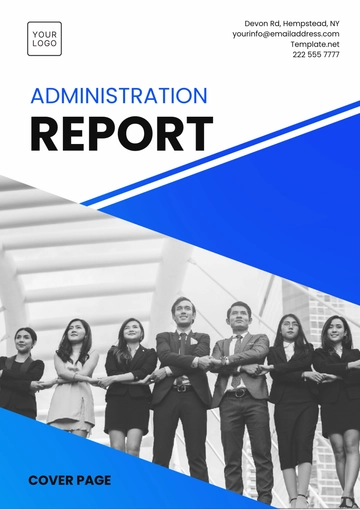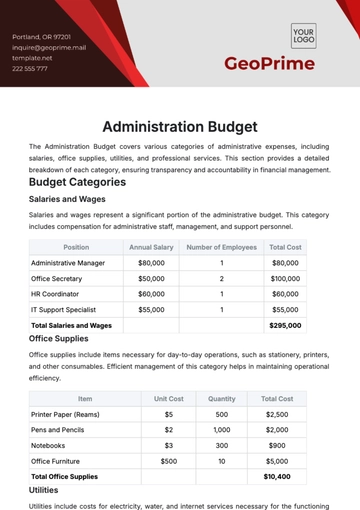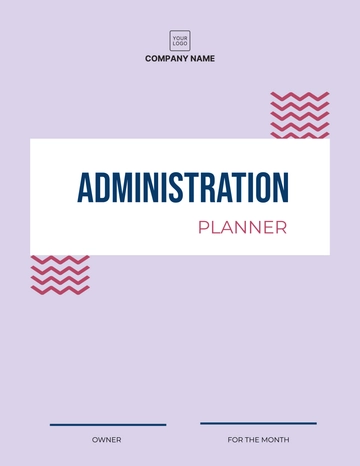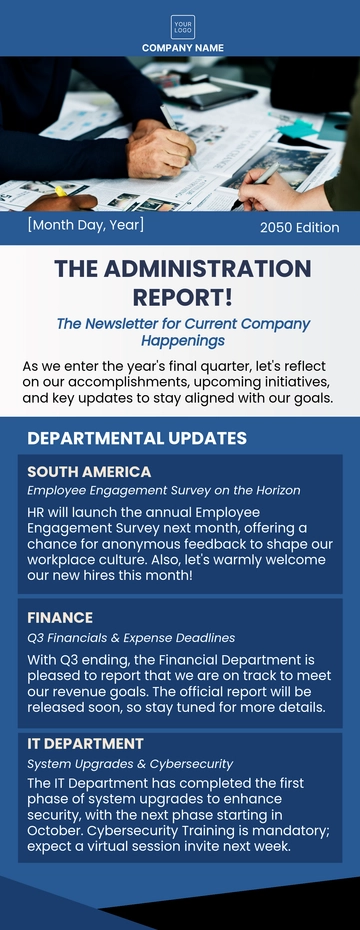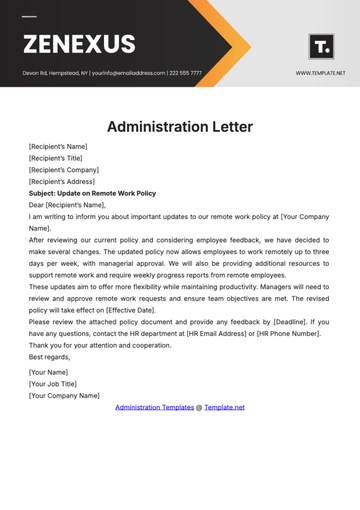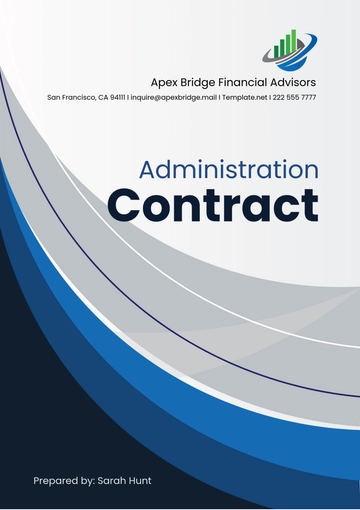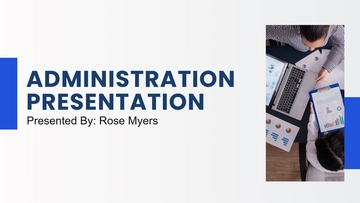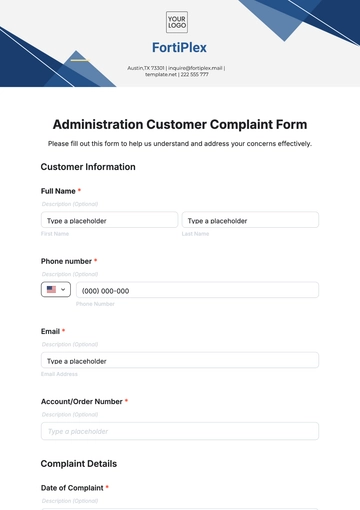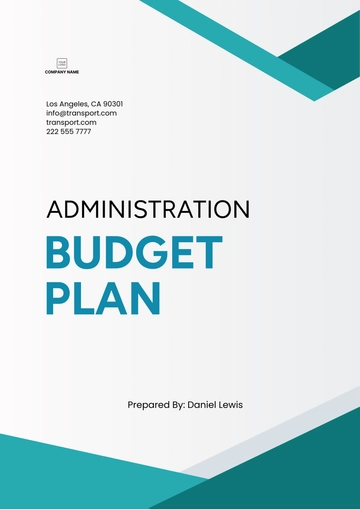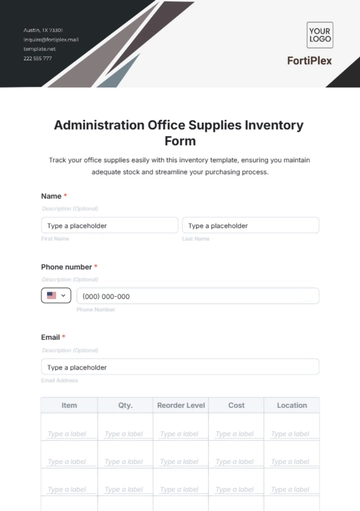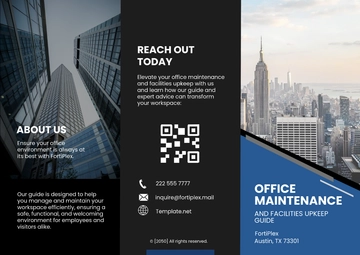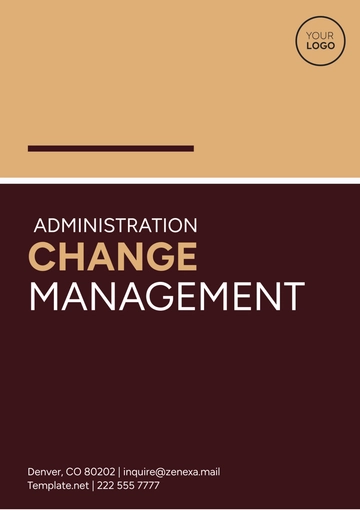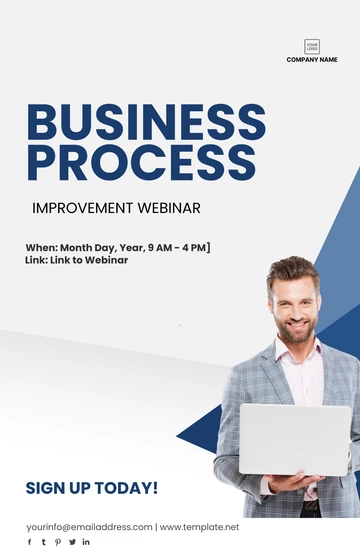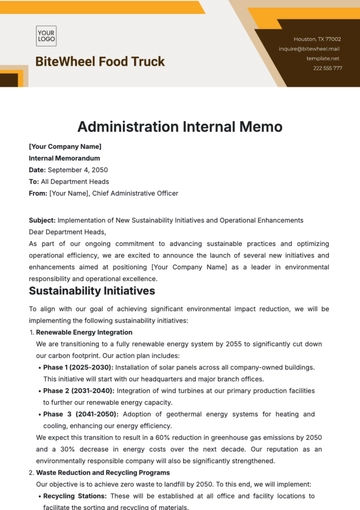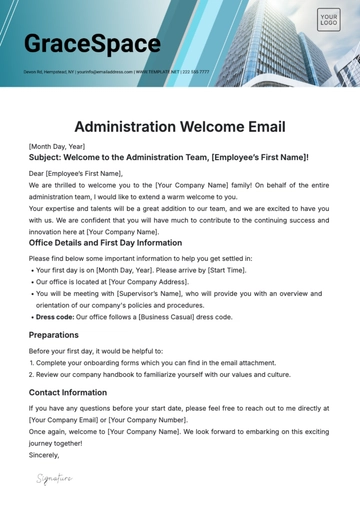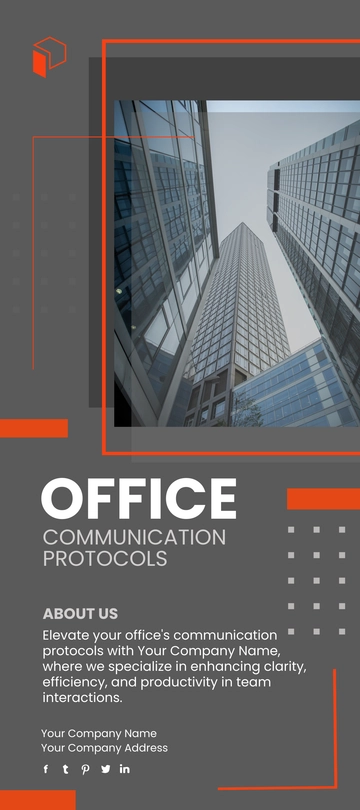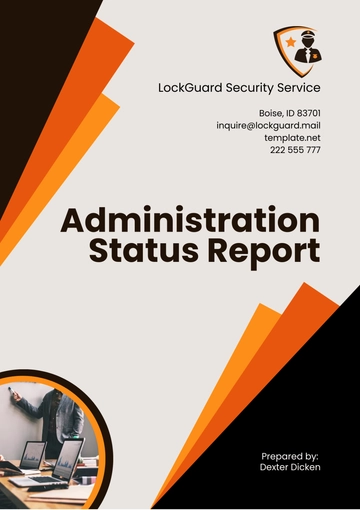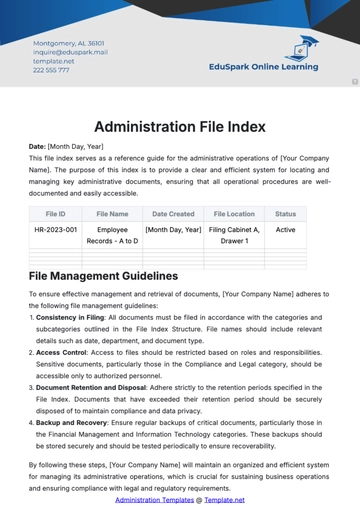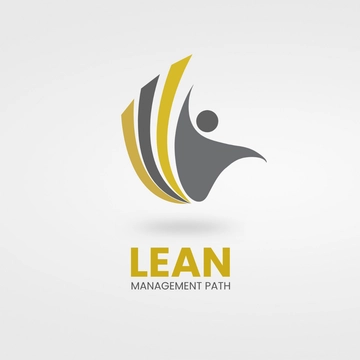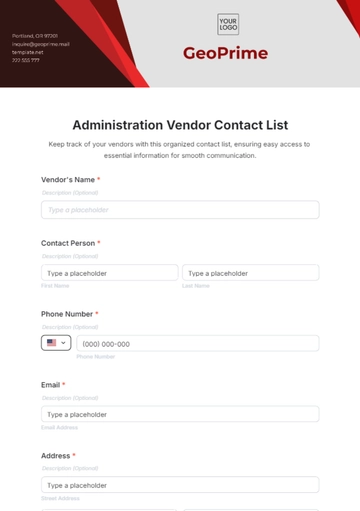Free Administration Supplier Relationship Management Protocol
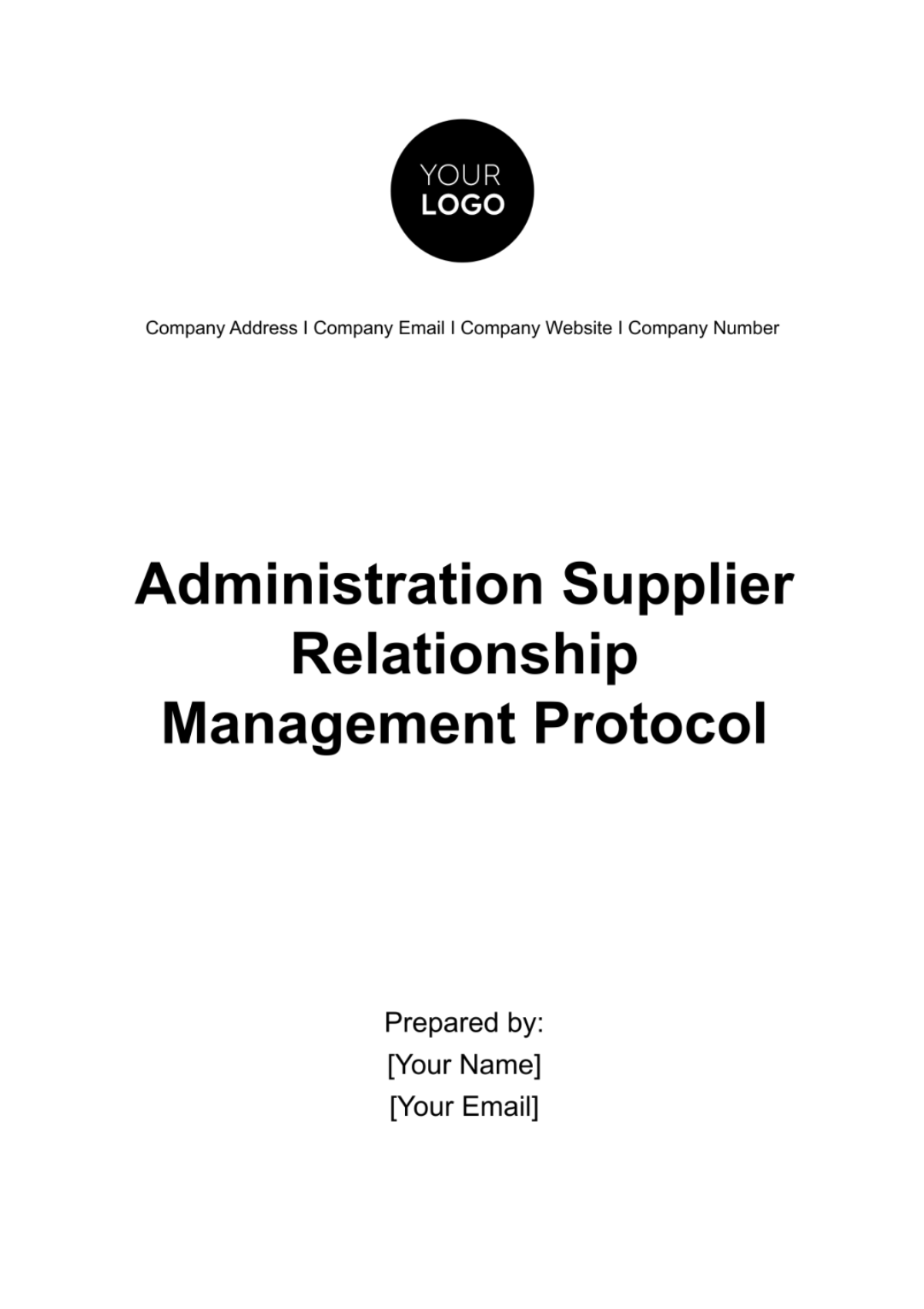
I. Introduction and Purpose:
At [Your Company Name], we recognize the crucial role that effective supplier relationships play in the success of our business. This Administration Supplier Relationship Management (ASRM) Protocol outlines our approach to managing supplier relationships to ensure mutual benefit, sustainable partnerships, and operational excellence.
II. Objectives and Goals:
The Administration Supplier Relationship Management Protocol of [Your Company Name] is guided by the following objectives and goals:
Foster strategic partnerships with suppliers to drive collaboration and innovation.
Enhance operational efficiency through streamlined procurement processes.
Mitigate risks and ensure business continuity in the supply chain.
Uphold ethical standards and promote sustainability throughout supplier relationships.
Drive continuous improvement in supplier performance and processes.
Ensure product quality and regulatory compliance through effective supplier management.
Maximize value and cost savings through strategic supplier partnerships.
Promote collaboration and knowledge sharing to drive mutual success.
Ensure supply chain resilience to anticipate and mitigate disruptions.
Safeguard reputation and brand integrity by upholding ethical conduct.
Empower supplier development and foster innovation within the supply chain.
Cultivate a culture of excellence and accountability in supplier relationships.
III. Supplier Selection and Onboarding:
A. Criteria for Selecting Suppliers:
The table below outlines various criteria used to evaluate potential suppliers, providing a structured approach to supplier selection.
Criteria | Description |
|---|---|
Quality | Evaluate the quality of products or services provided by the supplier. |
Reliability | Assess the supplier's track record in delivering products or services on time. |
Cost-effectiveness | Determine whether the supplier offers competitive pricing and value for money. |
Alignment with Values | Consider how well the supplier's values and business practices align with the company's. |
Sustainability Practices | Evaluate the supplier's commitment to environmental and social responsibility. |
Regulatory Compliance | Ensure that the supplier complies with relevant laws, regulations, and standards. |
Capability and Capacity | Assess the supplier's ability to meet current and future needs, including scalability. |
Financial Stability | Evaluate the supplier's financial health and stability to mitigate risks. |
B. Supplier Evaluation Process:
The Supplier Evaluation Process is a crucial step in ensuring the reliability, quality, and compliance of potential suppliers before engaging in business partnerships. By systematically assessing various aspects such as capabilities, performance history, and compliance with regulations, organizations can make informed decisions to select suppliers that align with their strategic objectives and standards.
Initial Assessment: Gather information about potential suppliers, including their products/services, capabilities, and reputation in the industry.
Request for Information (RFI): Send out RFIs to shortlisted suppliers to gather detailed information about their company, products/services, capabilities, financial stability, and compliance with relevant regulations.
Supplier Questionnaire: Provide suppliers with a questionnaire covering key aspects such as quality management systems, certifications, previous experience, and references.
Site Visits and Audits: Conduct site visits and audits to assess the supplier's facilities, processes, and quality control measures firsthand.
Performance History: Review the supplier's performance history, including delivery times, product quality, customer satisfaction, and any past issues or complaints.
References and Case Studies: Contact references provided by the supplier and review case studies to validate their capabilities and track record.
Quality Management Systems: Evaluate the supplier's quality management systems, certifications, and adherence to industry standards such as ISO 9001.
Financial Stability: Assess the supplier's financial stability, including their profitability, liquidity, debt levels, and ability to weather economic downturns.
Compliance and Regulatory Requirements: Ensure that the supplier complies with relevant laws, regulations, and industry standards, including environmental and social responsibility requirements.
Risk Assessment: Conduct a risk assessment to identify and mitigate potential risks associated with the supplier, such as supply chain disruptions, geopolitical factors, and financial instability.
Scoring and Ranking: Use a scoring system to objectively evaluate and rank suppliers based on predefined criteria, weighting factors based on their importance to the organization.
Decision Making: Make informed decisions about which suppliers to select based on the evaluation results, considering factors such as quality, reliability, cost-effectiveness, and strategic fit with the organization's goals and values.
C. Onboarding Procedures:
Efficient and thorough onboarding procedures are essential for establishing productive relationships with suppliers. By carefully navigating contract negotiations, documentation exchange, and performance expectations, organizations can seamlessly integrate suppliers into their operations for mutual success.
Contract Negotiation: Engage in negotiations to finalize contractual terms, including pricing, payment terms, delivery schedules, and service level agreements.
Documentation Exchange: Exchange necessary documentation, including contracts, agreements, insurance certificates, and tax forms, to formalize the relationship.
Supplier Training: Provide training sessions or materials to familiarize the supplier with company policies, procedures, quality standards, and expectations.
Integration with Systems: Integrate the supplier into procurement and supply chain management systems, including providing access to relevant portals or software platforms.
Supplier Performance Metrics: Establish key performance indicators (KPIs) and metrics to measure the supplier's performance and track progress over time.
Quality Assurance Processes: Communicate quality assurance processes and requirements to the supplier, including inspection procedures, testing protocols, and quality control measures.
Communication Channels: Establish clear communication channels and points of contact for inquiries, escalations, and feedback between the company and the supplier.
Initial Order Placement: Place initial orders with the supplier and monitor the fulfillment process to ensure smooth execution and timely delivery.
Feedback Mechanisms: Implement feedback mechanisms to solicit input from the supplier regarding the onboarding process and identify areas for improvement.
Performance Review Meetings: Schedule regular performance review meetings to assess the supplier's performance, address any issues or concerns, and identify opportunities for collaboration and improvement.
IV. Performance Monitoring and Evaluation:
A. Establishing Key Performance Indicators (KPIs):
This table outlines various key performance indicators that can be used to assess supplier performance effectively, providing a structured approach to monitoring and evaluation.
Performance Indicator | Description |
|---|---|
On-Time Delivery Rate | Percentage of orders delivered on or before the agreed-upon delivery date. |
Product Quality Metrics | Measures of product quality, including defect rates and customer complaints. |
Responsiveness to Inquiries | Time taken by the supplier to respond to inquiries or resolve issues. |
Lead Time Reduction | Reduction in lead times for order fulfillment and delivery processes. |
Cost Savings | Amount of cost savings achieved through improved efficiencies or negotiations. |
Innovation and Collaboration | Metrics related to collaborative innovation efforts and new product development. |
Compliance Adherence | Degree to which the supplier complies with contractual obligations and regulations. |
Customer Satisfaction | Measures of customer satisfaction and feedback related to supplier performance. |
B. Monitoring Mechanisms:
By employing these monitoring mechanisms, [Your Company Name] can effectively track and evaluate supplier performance, identify areas for improvement, and ensure alignment with business objectives and requirements.
Real-Time Tracking Systems: Implement systems to track supplier performance metrics such as delivery times, quality deviations, and inventory levels in real time.
Data Analytics Tools: Utilize data analytics software to analyze supplier data and identify performance trends, patterns, and outliers.
Performance Dashboards: Develop performance dashboards that provide visual representations of key performance indicators (KPIs) for easy monitoring and assessment.
Automated Alerts: Set up automated alerts and notifications to flag performance deviations or issues requiring attention.
Periodic Audits: Conduct periodic audits of supplier performance against agreed-upon standards, processes, and contractual obligations.
Supplier Self-Reporting: Implement self-reporting mechanisms where suppliers provide regular updates on their performance metrics and activities.
Benchmarking Analysis: Compare supplier performance against industry benchmarks and best practices to assess competitiveness and identify areas for improvement.
Continuous Feedback Loops: Establish continuous feedback loops with suppliers to solicit input, address concerns, and identify opportunities for performance enhancement.
C. Regular Performance Reviews:
Regular performance reviews provide opportunities to assess supplier performance, identify areas for improvement, and collaborate on strategies to drive continuous improvement and value creation. [Your Company Name] employs the following:
Scheduled Meetings: Hold regular meetings, such as monthly or quarterly, to review supplier performance and discuss key metrics and outcomes.
Performance Scorecard Reviews: Use performance scorecards to assess supplier performance against predefined key performance indicators (KPIs) during review meetings.
Data Analysis: Analyze historical performance data and trends to identify areas of improvement and track progress over time.
Stakeholder Feedback: Gather feedback from internal stakeholders, such as procurement, operations, and quality assurance teams, to provide insights into supplier performance.
Root Cause Analysis: Conduct root cause analysis to understand the underlying reasons for any performance deviations or issues and develop corrective actions.
Action Planning: Collaborate with suppliers to develop action plans to address performance gaps, set improvement targets, and establish timelines for implementation.
Continuous Improvement Initiatives: Encourage ongoing dialogue and collaboration with suppliers to drive continuous improvement initiatives and enhance performance.
Documentation: Document the outcomes of performance reviews, including action plans and decisions made, to track progress and ensure accountability.
V. Communication and Collaboration:
A. Establishing Communication Channels:
We maintain open lines of communication with suppliers through:
Regular meetings and check-ins.
Dedicated points of contact for inquiries and escalations.
Collaboration platforms for sharing information and documents.
Periodic performance review meetings to discuss progress and challenges.
B. Collaboration Opportunities:
We actively seek opportunities for collaboration with suppliers to:
Drive innovation and product development.
Improve processes and efficiency.
Identify cost-saving initiatives.
Address market trends and customer demands.
C. Handling Disputes and Conflicts:
In case of disputes or conflicts, we:
Facilitate constructive dialogue and mediation.
Refer to contractual terms and agreements.
Seek win-win solutions that preserve the partnership.
Escalate issues to senior management if necessary, while prioritizing resolution and relationship preservation.
VI. Risk Management:
A. Identifying and Assessing Risks:
We conduct risk assessments to identify and assess:
Supply chain disruptions.
Financial instability of suppliers.
Regulatory and compliance risks.
Geopolitical and macroeconomic factors.
Environmental and sustainability risks.
B. Mitigation Strategies:
To mitigate risks, we:
Diversify our supplier base.
Maintain buffer inventory for critical components.
Implement contingency plans for business continuity.
Monitor geopolitical and economic trends for early warning signs.
Collaborate with suppliers on risk mitigation strategies.
VII. Contract Management:
A. Maintenance of Supplier Contracts:
We maintain accurate and up-to-date supplier contracts, including:
Terms and conditions.
Pricing and payment terms.
Quality and performance expectations.
Confidentiality and intellectual property rights.
Termination and dispute resolution clauses.
B. Contract Renewals and Renegotiations:
We proactively manage contract renewals and renegotiations by:
Evaluating supplier performance against contract terms.
Identifying opportunities for improvement or cost savings.
Negotiating mutually beneficial agreements that reflect market conditions and business priorities.
Ensuring compliance with regulatory requirements and ethical standards.
C. Compliance Monitoring and Enforcement:
We enforce compliance with contractual terms and agreements through:
Regular audits and inspections.
Performance reviews and scorecards.
Disciplinary actions for non-compliance.
Continuous improvement of contract management processes.
VIII. Continuous Improvement:
Continuous improvement lies at the heart of effective supplier management, driving efficiency, innovation, and competitiveness. By fostering collaborative relationships, embracing lean principles, and encouraging innovation, [Your Company Name] can optimize supplier performance and achieve sustainable growth in today's dynamic business landscape.
Collaborative Approach: Foster collaboration with suppliers to identify and implement process optimization strategies.
Performance Reviews: Conduct regular reviews to assess supplier performance and address areas for improvement.
Feedback Mechanisms: Establish channels for supplier feedback to drive continuous improvement.
Lean Principles: Apply lean methodologies to streamline processes and eliminate waste.
Quality Management Systems: Ensure adherence to quality standards through robust quality management systems.
Innovation Initiatives: Encourage supplier-led innovation to drive competitiveness and market differentiation.
IX. Ethical and Sustainable Practices:
A. Ensuring Ethical Standards:
We uphold ethical standards throughout the supply chain by:
Prohibiting bribery, corruption, and unethical conduct.
Conducting due diligence on suppliers and business partners.
Promoting fair labor practices and human rights.
Ensuring compliance with relevant laws and regulations.
B. Promoting Sustainability:
We promote sustainability by:
Setting environmental and social responsibility goals.
Encouraging suppliers to adopt sustainable practices.
Monitoring and reducing environmental impact throughout the supply chain.
Supporting initiatives for responsible sourcing and waste reduction.
C. Compliance and Transparency:
We ensure compliance with ethical and sustainable practices through:
Supplier code of conduct and compliance requirements.
Audits and assessments of supplier practices.
Transparency in reporting environmental and social performance.
Collaboration with stakeholders to address sustainability challenges.
X. Documentation and Record-Keeping:
A. Contract Management:
Maintain comprehensive records of supplier contracts, including terms, conditions, and obligations.
Regularly review contracts to ensure compliance and address any necessary amendments or updates.
B. Documentation Exchange:
Establish a systematic process for exchanging documentation with suppliers, including contracts, agreements, and certifications.
Maintain accurate records of all documentation exchanged to facilitate traceability and auditability.
C. Supplier Information Management:
Maintain up-to-date records of supplier information, including contact details, performance metrics, and compliance documentation.
Centralize supplier information in a secure database or supplier management system for easy access and reference.
D. Audit Trails:
Create audit trails to track changes and revisions made to supplier-related documentation over time.
Ensure transparency and accountability by documenting the reasons for any changes or updates.
E. Quality Assurance Documentation:
Document quality assurance processes, inspections, and testing results related to supplier products or services.
Retain records of quality certifications, inspection reports, and non-conformance reports for compliance purposes.
F. Financial Records:
Maintain financial records related to supplier transactions, invoices, and payments.
Ensure accuracy and transparency in financial reporting to support budgeting and forecasting activities.
G. Compliance Documentation:
Document supplier compliance with regulatory requirements, industry standards, and company policies.
Retain records of compliance certifications, audits, and assessments to demonstrate adherence to legal and ethical standards.
H. Communication Records:
Keep records of all communications with suppliers, including emails, meeting minutes, and phone calls.
Document important decisions, agreements, and action items to ensure clarity and accountability.
I. Data Security and Confidentiality:
Implement measures to safeguard sensitive supplier information and maintain confidentiality.
Adhere to data protection regulations and industry best practices to prevent unauthorized access or disclosure.
J. Retention Policies:
Establish retention policies for supplier-related documentation to ensure compliance with legal and regulatory requirements.
Determine appropriate retention periods based on the nature and importance of the documentation.
K. Disposal Procedures:
Develop procedures for the secure disposal of obsolete or outdated supplier-related documentation.
Ensure compliance with data privacy regulations and environmental guidelines when disposing of sensitive information.
XI. Training and Development:
Investing in the training and development of suppliers is crucial for fostering collaboration, improving performance, and driving innovation within the supply chain. The table below outlines key aspects of training and development initiatives of [Your Company Name], highlighting the importance of tailored programs to address specific needs and support continuous improvement.
Aspect | Details |
|---|---|
Training Needs Assessment | Conduct regular assessments to identify training needs and gaps in supplier capabilities. |
Training Programs | Develop customized training programs tailored to address specific skillsets and requirements. |
Onboarding Training | Provide comprehensive training during the onboarding process to familiarize suppliers with policies, procedures, and quality standards. |
Quality Management Systems | Offer training on quality management systems, including ISO standards and quality control methodologies. |
Compliance Training | Conduct training sessions on regulatory compliance, ethical practices, and industry standards. |
Technology Adoption | Provide training on technology tools and platforms used for procurement, supply chain management, and collaboration. |
Continuous Development | Encourage continuous learning and development through ongoing training sessions and resources. |
Performance Improvement | Offer training and coaching to address performance gaps and enhance supplier performance. |
Supplier Development Programs | Implement supplier development programs to foster innovation, process improvement, and operational excellence. |
Feedback and Evaluation | Solicit feedback from suppliers to evaluate the effectiveness of training programs and identify areas for improvement. |
XII. Roles and Responsibilities:
Supplier Management Team:
Oversee the overall supplier management process, including selection, onboarding, performance evaluation, and relationship management.
Collaborate with internal stakeholders to define supplier requirements, negotiate contracts, and resolve issues as needed.
Procurement Department:
Collaborate with the supplier management team to identify sourcing needs and requirements.
Execute sourcing strategies, negotiate contracts, and manage supplier relationships to ensure alignment with organizational goals.
Quality Assurance/Quality Control Team:
Establish quality standards, inspection criteria, and testing protocols for supplier products or services.
Conduct audits, inspections, and quality assessments to ensure compliance with quality requirements and regulatory standards.
Logistics and Supply Chain Team:
Coordinate logistics, transportation, and inventory management activities related to supplier interactions.
Monitor supply chain performance, optimize inventory levels, and ensure timely delivery of materials and products.
Finance and Accounting Department:
Manage financial transactions, invoices, and payments related to supplier contracts and agreements.
Ensure accuracy and transparency in financial reporting, budgeting, and forecasting activities.
Legal and Compliance Team:
Review and negotiate supplier contracts to ensure legal compliance and mitigate risks.
Provide guidance on regulatory requirements, intellectual property rights, and contractual obligations related to supplier relationships.
Cross-Functional Teams:
Collaborate with cross-functional teams to define supplier requirements, assess performance, and address issues or concerns.
Facilitate communication and information exchange among departments to support effective supplier management practices.
XIII. Conclusion:
The [Your Company Name] Administration Supplier Relationship Management Protocol serves as a guiding framework for managing supplier relationships effectively and ethically. By adhering to these principles and practices, we aim to build sustainable partnerships that drive innovation, mitigate risks, and create shared value for all stakeholders. Through continuous improvement and collaboration, we remain committed to excellence in supplier relationship management and uphold the highest standards of integrity and accountability.
- 100% Customizable, free editor
- Access 1 Million+ Templates, photo’s & graphics
- Download or share as a template
- Click and replace photos, graphics, text, backgrounds
- Resize, crop, AI write & more
- Access advanced editor
Foster supplier partnerships with Template.net's Administration Supplier Relationship Management Protocol Template—an essential tool for administrative professionals to optimize supplier relationships. This editable and customizable protocol template, available on Template.net alongside our AI Editor Tool, provides a structured framework to manage supplier interactions, including supplier selection, performance evaluation, contract negotiation, and communication protocols.
